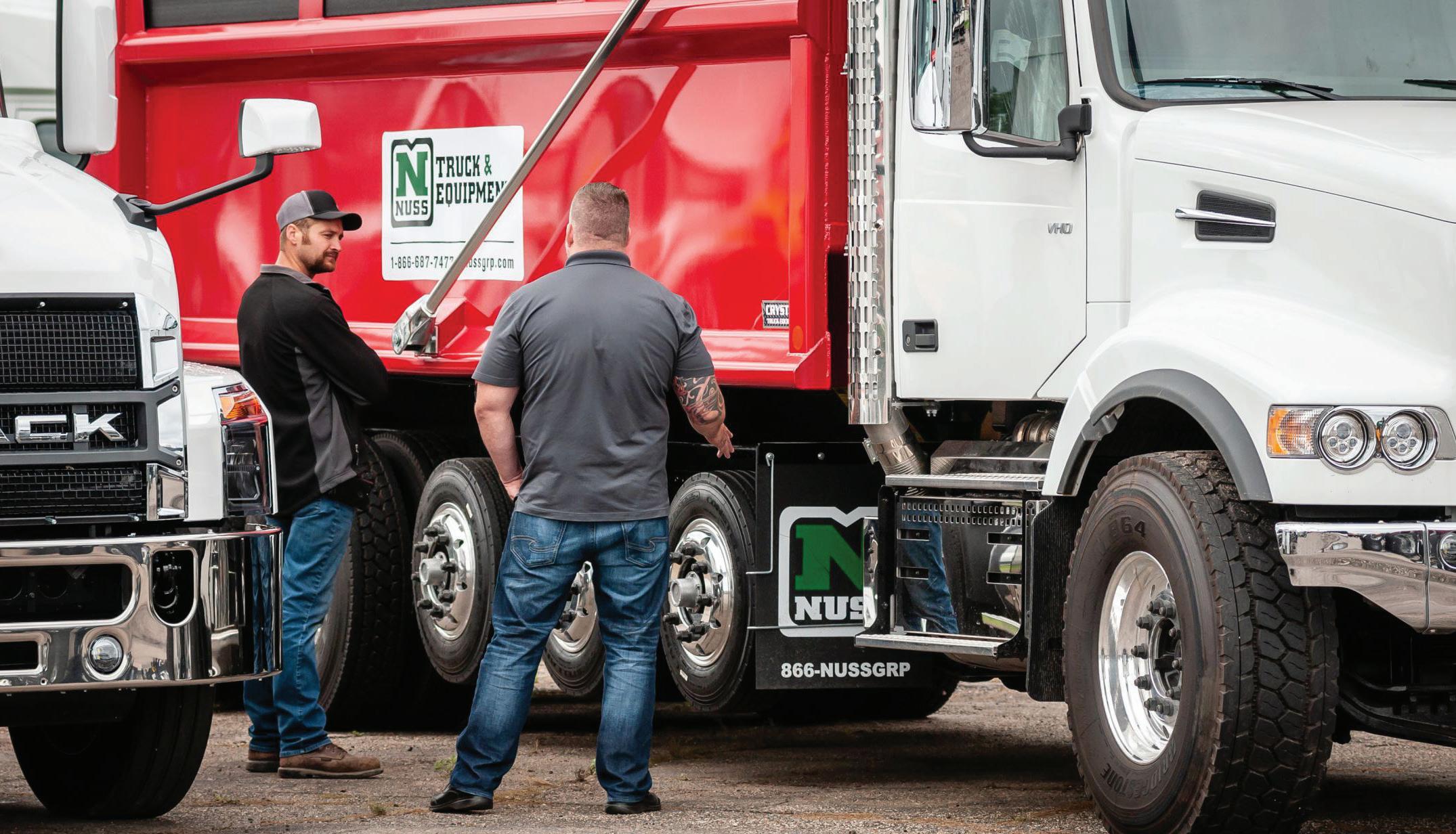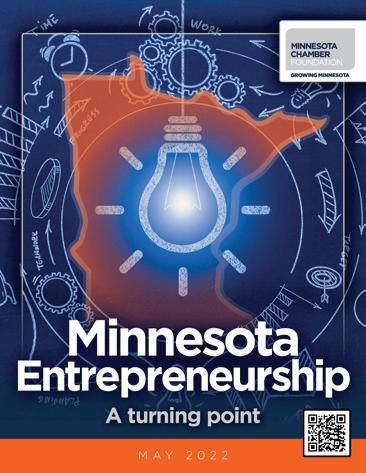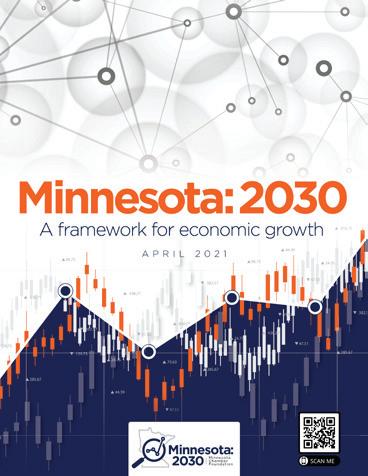BUSINESS
From a bygone era to reclaiming our competitive edge


From a bygone era to reclaiming our competitive edge


It has been nearly 50 years since the Time cover story touting the “Minnesota Miracle” with Governor Wendell Anderson. At that time, Minnesota was recognized for outperforming other states: economic growth was above average and personal incomes were significantly increasing.

But 1973 is now a long time ago - and past achievements do not guarantee future success. Global competition has intensified. Mobility of capital is even more pronounced. Remote work has increased the ability to work from anywhere. And technology has forever changed how we live, shop and work. We have much to be proud of in Minnesota. We have a highly diverse industry base, a talented and hardworking workforce, beautiful natural resources and high innovation. But there are ways in which Minnesota no longer beats the competition.
Among this year’s findings:
• Our economy shows mixed results. Despite historically low unemployment rate that shows Minnesotans are working hard, Minnesota’s GDP and job growth have been below the national average for the past five years. The October jobs report showed positive progress as Minnesota exceeded the national job growth. This may be a short-term uptick as the state’s November budget forecast predicts flat job growth in 2023 and 2024.
• The tax climate exacerbates the already-high cost of doing business, and makes us less competitive as 27 other states have reformed their tax codes to attract investment, talent and growth.
• Minnesota continues to be a hotbed of private-sector innovation and continues to support its high five-year startup survival rate.
• Ongoing strategic infrastructure investment has improved rankings in highway performance, and Minnesota has advantages in shipping and logistics, with total freight rail miles outperforming its size.
• The workforce continues to be a simultaneous strength and challenge. Our state has a high-quality workforce, but continues to wrestle with a historic worker shortage and low rate of migration into Minnesota from other states.
This year’s Business Benchmarks report goes beyond the analysis of where Minnesota stands in economic categories. This year, we compare Minnesota to other states that are outpacing us in these categories. What are the trends that sets them apart? What intentional steps are they taking to help their economies grow?
Colorado, Indiana, North Carolina, Tennessee and Utah have all seen economic improvements in several categories. They have similarities to Minnesota in the size of their economy, industry strengths, populations, and natural and cultural amenities. Each of them has a story to tell, in making their state more affordable, improving their workforce, and becoming more competitive overall.
We also examined neighboring states Wisconsin, Iowa and South Dakota (North Dakota’s recent history with the oil industry offers a less comparable analysis). Minnesota employers compete with the economic advantages enjoyed in these states every day. When considerations about growth or expansion are in play, businesses recognize Minnesota’s quality workforce, but may choose a neighboring state because they offer a quality workforce and are more affordable.
There is no silver bullet for economic development. The growth of any state’s economy depends on a complicated and diverse set of conditions, and it’s the cumulative impact that decides whether an economy succeeds or lags behind its competition.
But singular decisions from business leaders and policymakers can make a huge impact on whether Minnesota is an attractive and affordable place to live, work and grow a business. We are providing this deeper comparative analysis to help understand the formula that goes into it.
Make no mistake - Minnesota is an exceptional place to live and raise a family, and start and grow a business. But the data tell us that the state is not living up to its economic potential. Understanding our competitive strengths and weaknesses can determine what is needed to regain our competitive edge.

We urge business and policy leaders alike to read this report and support policies and private sector-led efforts to get Minnesota growing again.
Doug Loon President and CEO, Minnesota Chamber of Commerce August 1973 TIME, Minnesota: A state that works
August 1973 TIME, Minnesota: A state that works

nflation and high costs are impacting consumers across the nation. But in some states, like Minnesota, businesses and families are experiencing a compounding effect from self-imposed headwinds like high tax rates. Minnesota’s tax burdens continue to be among the highest in the nation, with the sixth-highest individual income tax rate and the corporate tax rate set to be highest in the nation by 2024. Other states - 27 states, to be exact - have reformed their tax systems in the last two years to become more attractive for business investment, talent and growth. The fact that these states took action on the heels of the pandemic amid all of its uncertainty shows that forward progress can be achieved. Inaction is also a choice and could make Minnesota’s tax structure one of the least competitive in the nation.
strong and talented workforce is a tenet of Minnesota’s historical economic strengths. It is also critical for future success. Earlier this year, Minnesota simultaneously experienced a historically low unemployment rate and historically high worker shortage. The state has higher-than-average labor participation and consistently gains workers from overseas. But a negative net domestic migration means Minnesota is losing talent to other states. Test scores declined in Minnesota as well as the nation after COVID-19, while Minnesota saw a slight improvement in 8th-grade reading rankings - there was a concerning drop in 4th-grade reading scores (from 12th in 2019 to 28th in 2022). Minnesota’s workforce is a well-established strength, but steps must be taken to align the talent pipeline with the needs of the future and improve student learning.
Extempore provides an educational linguistics tool to develop reading, writing, speaking and cultural skills.

Digi-Key Electronics distributes electronic components and automation products worldwide.

The Flint Hills Resources Pine Bend Refinery produces transportation, heating and other fuels.

WSB is a forward-thinking design and consulting firm, specializing in engineering, community planning, environmental and construction services.

Minnesota’s ranking on segments of the economy defines the state’s relative strength. As previously stated, there are undeniable strengths of Minnesota’s highly developed economy. The diverse base of industries, hardworking and educated workforce, industry leading companies, in addition to high innovation rates and abundant natural resources and cultural amenities. But the elements of our economy don’t exist on their own - whether they give us a competitive advantage is dependent on the actions of other states as well.
Many affectionately reference the “Minnesota Miracle” to remember a time when Minnesota was outperforming other states: the development of the computer industry fueled above average-economic growth, and personal incomes were significantly increasing. According to the Minnesota Chamber Foundation’s report Minnesota 2030: A framework for growth, the state continued that position of strength by outperforming the United States for more than three decades. State job growth exceeded the nation’s for 27 out of those 35 years, and incomes grew alongside until reaching a peak in 2004. It was, without question, an important period for our state’s economic growth.
But since 2005, Minnesota’s economy has grown more slowly than the U.S., averaging just 1.4% real GDP growth and 0.7% job growth, compared to 1.8% and 1.2%, respectively, for the U.S.
Real GDP compound average annual growth rate: 2016-2021
Utah
Colorado 3.2%
Tennessee 2.6%
North Carolina 2.3%
United States 2.1% Indiana 1.6%
South Dakota 1.5% Minnesota 1.3% 1.1% 1.0%
Iowa Wisconsin
Understanding the state’s competitive strengths and weaknesses can determine what is needed to regain our competitive edge. States with either high-performing economies or that share regional traits can help understand where Minnesota can improve. In this report, comparison states include Colorado, Indiana, North Carolina, Tennessee and Utah (Utah has a smaller GDP and population but is a benchmark of top-performing growth). Neighboring states include Wisconsin, South Dakota and Iowa (North Dakota was excluded due to the volatile nature of the oil industry).
4.8%
National GDP growth rank: 2016-2021
1st 6th 11th 14th 22nd 26th 28th 33nd 35th
When it comes to overall economic performance, regional dynamics play a prominent role, with states in the Sunbelt and west experiencing more robust growth than Midwest states. Minnesota, Iowa and Wisconsin follow that trend, and consistently lag in the state rankings. But Indiana and South Dakota, each with low tax rates, are slightly above average, showing that Midwest states can outperform regional peers and
When Mitch Daniels took office as governor of Indiana in 2005, the state’s economy was underperforming. Under his leadership, the state consolidated their economic development structure and narrowed its focus on attracting new private-sector jobs and investment. Since then, Indiana has seen $31 billion in new investment and nearly 160,000 jobs as 1,390 companies have decided to make Indiana their home for business. Even on the heels of the COVID-19 pandemic, their job growth rate outperforms the national average.
There is a clear delineation between the economic performance of high-cost, high-tax states and its lower cost counterparts. Twenty-seven states have reformed their tax systems in the last two years, a step that makes them attractive to business investment, talent and growth. Twenty-five of those 27 states dropped their income or corporate tax rates, or both.
● Indiana, Utah and Colorado have both corporate and individual rates under 5%.
● South Dakota has no corporate or individual tax rate.
● Tennessee doesn’t have an income tax, and their corporate tax rate is 6.5%, considerably lower than Minnesota’s 9.86%.
● Iowa recently lowered their individual income tax rate to a flat 3.9% and slashed their corporate rate from 9.8% to 5.5% (with phase-in and triggers).
Other costs make a difference too, with industrial electric costs higher in Minnesota than in all of the comparison states in this report - Colorado, Indiana, North Carolina, Tennessee, Utah, Iowa, South Dakota and Wisconsin. Each of those states also have lower health care premiums than Minnesota for single coverage, with the exception of Indiana.
join the top half of states in major indicators. South Dakota actually increased its GDP and population post-pandemic.
Of the comparison states in this report, Colorado, Tennessee, North Carolina and Utah are in the top tier for economic growth. Tennessee’s GDP growth is most impressive, jumping 9% in one year between 2020 and 2021, the most growth experienced in two decades.
The strength of private-sector innovation in Minnesota has long-driven its economic growth. But other states are showing their relative strength and surpassing Minnesota in many categories. Colorado and Utah are in the top 10 for venture capital per capita, with Colorado at $1,121 and Utah at $1,211. That’s nearly five times more than Minnesota’s $235 per capita.
South Dakota, North Carolina, Colorado and Utah’s new entrepreneurship rates are in the top 15 of the nation.
North Carolina has been a leader in pro-growth, structurally sound state tax systems for nearly a decade. Prior to 2013, the state ranked low in affordability competitiveness. That year, lawmakers passed a massive reform bill focused on simplifying and reducing their state taxes. The economic impact of these changes has attracted investment, and led to job creation and wage growth. And they keep making themselves more affordable. In 2021 policymakers further reduced the flat income tax rate and will eventually phase out their corporate tax altogether.
Colorado 30th 41st 4.55% 35th 4.55% 17th $5,668 16th 8.31 c/kwh 41st $6,909 11th/102.9 Indiana 42nd 38th 4.9% 40th 3.23% 31st $4,707 15th 8.32 c/kwh 15th $7,635 31st/92.5
North Carolina 41st 45th 2.5% 31st 4.99% 41st $4,209 41st 6.48 c/kwh 36th $7,130 38th/91.8
Tennessee 37th 24th 6.5% NONE 51st $3,719 47th 6.30 c/kwh 45th $6,741 36th/92.2 Utah 43rd 40th 4.85% 32nd 4.95% 34th $4,467 45th 6.34 c/kwh 49th $6,707 25th/95.3 Iowa 13th 10th 8.4% 17th 6.0% 21st $5,434 39th 6.65 c/kwh 40th $6,999 45th/91.0
South Dakota 49th NONE NONE 35th $4,466 21st 8.06 c/kwh 24th $7,338 42nd/91.5 Wisconsin 24th 14th 7.9% 8th 7.65% 23rd $5,269 20th 8.22 c/kwh 32nd $6,254 28th/93.2
Higher taxes and costs don’t necessarily translate to better infrastructure outcomes. Four of the comparison states in this report rank better in highway performance than Minnesota: North Carolina, Tennessee, Utah and South Dakota. These other states also have strong broadband infrastructure and large airports for the flow of goods and commerce. Even though Minnesota has a major international airport, ranking 12th best in the nation, North Carolina and Colorado have more flights than Minnesota.
A strong and talented workforce is a key ingredient of any state’s success. As previously discussed, Minnesota has grown its population over the past five years, but this is principally from international immigration and struggles to bring workers from other states. In 2021, Minnesota actually lost 15,947 workers to other states.
By comparison, North Carolina, Tennessee, Utah and Colorado were among the top 15 states for domestic migration.


Colorado has a low jobless rate and high labor participation, similar to Minnesota. But they’ve also experienced sharp gains in employment, specifically in leisure and hospitality, professional and business services.
One way to build a workforce is attracting workers from other states; another is to build a long-term talent pipeline at home. Most states are struggling with a post-pandemic downward trend in test scores among their students. Regionally, Wisconsin and South Dakota have better 8th-grade reading scores than Minnesota (tied for 9th best in the nation, compared to Minnesota at 18th). Students in Colorado and Utah scored high in both 8th- and 4th-grade reading, scoring near the top of the nation, compared to Minnesota, which ranks 28th
Lagging other states in economic growth rates may not be a significant concern for Minnesota in the short-term (so long as absolute levels are high). But slow growth over time can erode the state’s relative advantage and may not maintain the strength of our economy, in the future as we have achieved over the past few decades. A strong and growing economy requires a strong and growing private sector. Fewer opportunities for private sector growth can erode the high quality of life. Minnesota should address policies creating a roadblock to private sector growth and undermining investment, entrepreneurship, talent recruitment and retention.

Tennessee seems to have a winning combination of low costs and high opportunity. They are one of the fastest-growing economies in the nation, with a surge in GDP and an increasing number of business startups. This momentum means more jobs, higher wages and a population that is expected to grow by 1 million people by 2040.




The Minnesota Chamber of Commerce has provided a voice – the collective voice –for businesses for more than 110 years. They have fostered their vision of a future for business that improves the lives of all Minnesotans by successfully shaping Minnesota’s economy and helping businesses thrive and grow within the state.
The average Chamber member stays for more than 30 years. What’s your why?
Bret Weiss, President and CEO, WSB
“My why is leadership development. They have a fundamental commitment to developing relationships and delivering content through specific programs that drive business excellence… My membership in the Minnesota Chamber is one of the most important investments I make every year.”
Brooke Lee, CEO, Anchor Paper Co.
“My why is empowerment. Being ahead of the information curve [during the COVID-19 pandemic] enabled me to lead my business from the front and make key decisions in a timely manner. Thank you, Minnesota Chamber of Commerce, for empowering us to raise our voices and be heard.”
We are Minnesota’s largest broad-based business organization representing more than 6,300 companies – and more than half a million employees –throughout Minnesota. The Chamber builds on its legacy as a voice for business by advancing public policy that grows jobs and the economy, and providing valuable services to members so they stay and grow in Minnesota. A business climate that allows for innovation and forward-thinking leadership will help grow the strength of Minnesota’s economy for future generations.
Kelly Larson, CFO, Summit Brewing Company


“My why is reliability. The Minnesota Chamber was there for Summit as a growing company in so many ways during the COVID-19 pandemic. But it’s not just during times of a pandemic when we value our membership. I understand the importance of the work the Minnesota Chamber does, which makes our membership an investment we will make every year.”



Business insurance protects your company from losses that occur during the course of normal business, property damage, legal liability and employeerelated risks.
Employee benefits make you more competitive. The Minnesota Chamber has been a trusted partner in offering low-cost benefits for nearly 50 years.
NEW! ChamberHealth is high-quality, affordable health insurance for small and mid-sized employers.
Understanding Minnesota’s economic future is key to its long-term success. The Minnesota Chamber Foundation and Grow Minnesota! program play a critical role in strengthening the business environment to improve the lives of all Minnesotans through economic research.


Minnesota Chamber advocacy is further bolstered by the 40-plus partners who are unified as the Minnesota Chamber Federation – local chambers of commerce that adopt and advocate for your top legislative priorities.
Albert Lea Freeborn County Chamber of Commerce
Alexandria Lakes Area Chamber of Commerce
Anoka Area Chamber of Commerce
Apple Valley Chamber of Commerce
Austin Area Chamber of Commerce
Bemidji Chamber of Commerce
Brainerd Lakes Chamber
Burnsville Chamber of Commerce
Cloquet Chamber of Commerce
Cuyuna Lakes Chamber of Commerce
Dakota County Regional Chamber of Commerce
Duluth Area Chamber of Commerce
East Grand Forks/Grand Forks Chamber of Commerce
Eden Prairie Chamber of Commerce
Elk River Area Chamber of Commerce
Fargo Moorhead West Fargo Chamber of Commerce
Faribault Area Chamber of Commerce & Tourism
Fergus Falls Area Chamber of Commerce
Glenwood Lakes Area Chamber of Commerce
Grand Rapids Area Chamber
Greater Mankato Growth Inc.
Greater Stillwater Chamber of Commerce
Hastings Area Chamber of Commerce & Tourism Bureau
Hermantown Area Chamber of Commerce
Hibbing Area Chamber of Commerce
Hutchinson Area Chamber of Commerce
International Falls Chamber of Commerce
Lake County Chamber of Commerce
Lakeville Area Chamber of Commerce & CVB
Laurentian Chamber of Commerce
Litchfield Chamber of Commerce
Marshall Area Chamber of Commerce
MetroNorth Chamber of Commerce
New Ulm Area Chamber of Commerce
Northfield Area Chamber of Commerce
Owatonna Area Chamber of Commerce and Tourism
Pipestone Area Chamber of Commerce
Redwood Falls Area Chamber of Commerce
River Heights Chamber of Commerce
Rochester Area Chamber of Commerce
Saint Cloud Area Chamber of Commerce
Shakopee Area Chamber
Southwest Metro Chamber of Commerce
Twin Cities North Chamber of Commerce
Waconia Chamber of Commerce
Waseca Chamber of Commerce
White Bear Area Chamber of Commerce
Willmar Lakes Area Chamber of Commerce
Winona Area Chamber of Commerce
Woodbury Area Chamber of Commerce
Worthington Area Chamber of Commerce
380 St Peter St Suite 1050, St Paul, MN 55102 651.292.4650 | mnchamber.com